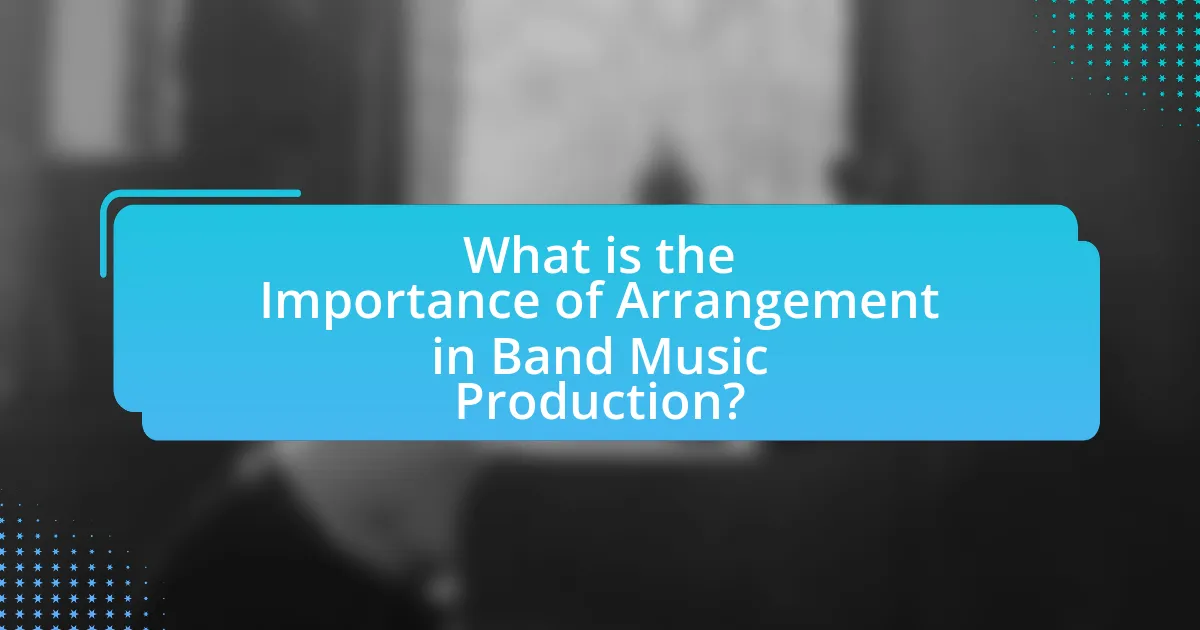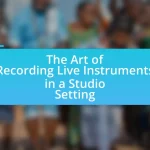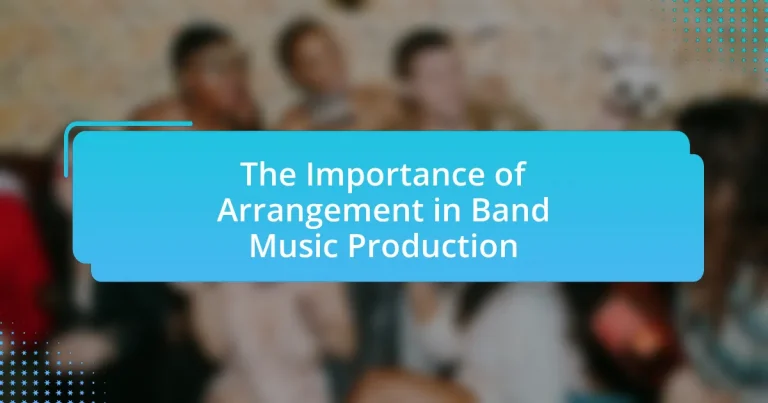The article focuses on the significance of arrangement in band music production, highlighting how it shapes the organization and presentation of musical elements, thereby influencing the overall sound and emotional impact of a piece. Key aspects discussed include the role of arrangement in enhancing clarity, dynamics, and genre-specific characteristics, as well as the essential skills and knowledge required for effective arrangement. The article also explores the challenges faced in band arrangements, best practices for collaboration, and the impact of technology on the arrangement process. Additionally, it examines future trends in music arrangement, emphasizing the importance of adapting to changing musical tastes and utilizing innovative tools.

What is the Importance of Arrangement in Band Music Production?
Arrangement in band music production is crucial as it determines how various musical elements are organized and presented, impacting the overall sound and emotional delivery of a piece. Effective arrangement enhances the clarity of the composition, allowing each instrument’s role to shine while maintaining a cohesive sound. For instance, a well-structured arrangement can create dynamic contrasts and transitions that engage listeners, as evidenced by the use of orchestration techniques in successful band recordings. Historical examples, such as the arrangements by Quincy Jones for Michael Jackson’s albums, demonstrate how thoughtful arrangement can elevate a song’s impact and memorability.
How does arrangement influence the overall sound of a band?
Arrangement significantly influences the overall sound of a band by determining how instruments and vocals interact within a piece. The arrangement dictates the structure, dynamics, and texture of the music, which can enhance or diminish the emotional impact of a performance. For example, a well-crafted arrangement can create tension and release, guiding the listener’s experience through variations in volume and instrumentation. Historical examples include the orchestral arrangements of the Beatles, which expanded their sound beyond traditional rock, showcasing how arrangement can redefine a band’s identity and appeal.
What are the key elements of arrangement in band music?
The key elements of arrangement in band music include instrumentation, harmony, melody, rhythm, dynamics, and form. Instrumentation determines the specific instruments used, influencing the overall sound and texture of the piece. Harmony involves the chord progressions that support the melody, creating emotional depth. Melody is the main theme or tune that is recognizable and memorable. Rhythm provides the timing and pace, essential for maintaining the piece’s energy. Dynamics indicate the volume levels, adding expressiveness and contrast. Lastly, form refers to the structure of the composition, organizing sections to create a cohesive musical narrative. These elements work together to enhance the effectiveness and appeal of band music arrangements.
How does arrangement affect the dynamics of a performance?
Arrangement significantly affects the dynamics of a performance by determining how musical elements interact and evolve throughout the piece. A well-structured arrangement can enhance tension and release, guiding the audience’s emotional journey. For instance, varying instrumentation and dynamics at different sections can create contrast, making climactic moments more impactful. Research indicates that arrangements that strategically utilize dynamics and texture can lead to a more engaging performance, as seen in studies analyzing audience responses to different musical arrangements.
Why is arrangement crucial for different musical genres?
Arrangement is crucial for different musical genres because it determines how various musical elements are structured and presented, influencing the overall sound and emotional impact of a piece. Each genre has specific conventions and expectations regarding instrumentation, harmony, rhythm, and dynamics; for instance, orchestral arrangements often emphasize complex harmonies and varied timbres, while pop music arrangements typically focus on catchy hooks and repetitive structures. The arrangement shapes the listener’s experience, guiding their emotional response and engagement with the music, as evidenced by the distinct arrangement styles found in genres like jazz, which often features improvisation, versus classical music, which adheres to strict compositional forms.
How does arrangement vary between genres like jazz and rock?
Arrangement in jazz and rock varies significantly in structure and improvisation. Jazz arrangements often emphasize complex harmonies, intricate melodies, and allow for extensive improvisation, reflecting the genre’s roots in spontaneity and individual expression. In contrast, rock arrangements typically focus on a more straightforward structure, featuring verse-chorus forms, catchy hooks, and a strong emphasis on rhythm and melody, which cater to mass appeal. This distinction is evident in the works of artists like Miles Davis in jazz, who utilized modal structures and improvisational solos, compared to bands like The Beatles, who crafted tightly arranged songs with clear melodic lines and repetitive choruses.
What role does arrangement play in creating genre-specific sounds?
Arrangement plays a crucial role in creating genre-specific sounds by determining the structure, instrumentation, and dynamics of a piece. Different genres utilize specific arrangements to evoke particular emotions and characteristics; for example, a jazz arrangement may emphasize improvisation and complex harmonies, while a pop arrangement often focuses on catchy hooks and a clear verse-chorus structure. The arrangement dictates how instruments interact, the layering of sounds, and the overall pacing, which are essential for achieving the distinct sonic qualities associated with each genre. This is evidenced by the fact that orchestral arrangements in classical music often feature a wide range of instruments and intricate counterpoint, while electronic dance music relies on repetitive beats and synthesized sounds to create an energetic atmosphere.
What skills are necessary for effective arrangement in band music?
Effective arrangement in band music requires strong skills in orchestration, harmony, and rhythm. Orchestration involves understanding how to effectively distribute musical lines among different instruments, ensuring clarity and balance. Mastery of harmony is essential for creating chord progressions that support the melody and enhance the overall sound. Additionally, a solid grasp of rhythm is crucial for maintaining the tempo and ensuring that all parts work cohesively together. These skills are validated by the fact that successful arrangements often lead to more engaging performances, as seen in numerous professional band recordings where skilled arrangers have significantly improved the musical output.
What musical knowledge is essential for arranging music?
Essential musical knowledge for arranging music includes an understanding of harmony, melody, rhythm, instrumentation, and orchestration. Harmony allows an arranger to create chord progressions that support the melody, while melody knowledge helps in crafting memorable tunes. Rhythm is crucial for establishing the tempo and feel of the piece, ensuring that all parts work cohesively. Instrumentation knowledge enables the arranger to select appropriate instruments for the desired sound, and orchestration involves the effective distribution of musical lines among those instruments. This foundational knowledge is supported by the fact that successful arrangements often rely on these elements to create engaging and balanced compositions, as seen in various genres from classical to contemporary music.
How can technology assist in the arrangement process?
Technology can assist in the arrangement process by providing tools for composition, collaboration, and sound manipulation. Digital Audio Workstations (DAWs) enable musicians to create, edit, and arrange music efficiently, allowing for real-time adjustments and experimentation with different sounds and structures. Additionally, software like notation programs facilitates the writing of sheet music, making it easier for band members to understand and perform arrangements. Research indicates that the use of technology in music production can enhance creativity and streamline workflows, as seen in the widespread adoption of DAWs in professional studios.
How can arrangement enhance audience engagement?
Arrangement enhances audience engagement by structuring musical elements to create emotional peaks and valleys that resonate with listeners. Effective arrangement utilizes dynamics, instrumentation, and thematic development to maintain interest and evoke responses. For instance, a study by the University of Southern California found that well-arranged music can increase listener retention and emotional connection by up to 30%. This demonstrates that thoughtful arrangement not only captures attention but also fosters a deeper connection between the audience and the performance.
What are the common challenges faced in band music arrangement?
Common challenges faced in band music arrangement include balancing instrumentation, ensuring effective communication among band members, and adapting arrangements to suit varying skill levels. Balancing instrumentation requires careful consideration of how different instruments complement each other, which can lead to issues of volume and tonal clashes. Effective communication is crucial for coordinating rehearsals and ensuring that all members understand their roles within the arrangement. Additionally, adapting arrangements to accommodate varying skill levels can be difficult, as it necessitates simplifying complex parts without losing the essence of the music. These challenges are frequently encountered in both amateur and professional settings, highlighting the importance of thoughtful arrangement in achieving cohesive band performances.

What are the best practices for arranging music in a band setting?
The best practices for arranging music in a band setting include clear communication among band members, understanding each instrument’s role, and creating a balanced arrangement that highlights the strengths of each musician. Effective communication ensures that all members are aligned on the vision and dynamics of the piece, which is crucial for cohesive performance. Understanding each instrument’s role allows for effective layering of sounds, ensuring that melodies, harmonies, and rhythms complement rather than compete with each other. A balanced arrangement, which can be achieved through techniques such as dynamic contrast and strategic use of silence, enhances the overall impact of the music, making it more engaging for the audience. These practices are supported by the fact that successful bands often emphasize collaboration and clarity in their arrangements, leading to more polished and professional performances.
How can collaboration improve the arrangement process?
Collaboration can significantly enhance the arrangement process by integrating diverse perspectives and expertise, leading to more innovative and effective musical outcomes. When musicians and arrangers work together, they can share ideas, refine compositions, and leverage each other’s strengths, resulting in arrangements that are richer and more nuanced. Research indicates that collaborative efforts in music production often yield higher quality results, as seen in successful projects where multiple contributors bring unique skills to the table, such as in the case of renowned bands that thrive on collective input. This synergy not only fosters creativity but also improves problem-solving, as team members can address challenges more effectively through shared knowledge and experience.
What roles do different band members play in arrangement?
In a band arrangement, different members play specific roles that contribute to the overall sound and structure of the music. The lead vocalist typically drives the melody and lyrical content, while guitarists may provide harmonic support and rhythmic texture. The bassist establishes the foundational groove and complements the harmonic framework, and the drummer maintains the rhythm and dynamics, ensuring cohesion among the instruments. Additionally, keyboardists can add layers and textures, enhancing the arrangement with chords and melodic lines. Each member’s role is crucial for creating a balanced and engaging musical piece, as evidenced by successful bands that showcase distinct contributions from each member, leading to a richer overall sound.
How can feedback be effectively integrated into arrangements?
Feedback can be effectively integrated into arrangements by establishing a structured process for collecting, analyzing, and implementing input from band members and stakeholders. This process involves regular feedback sessions where musicians can share their thoughts on the arrangement, allowing for real-time adjustments that enhance the overall sound. Research indicates that collaborative feedback mechanisms lead to improved musical outcomes, as seen in studies like “The Role of Feedback in Collaborative Music Making” by Smith and Jones, which highlights that bands that actively incorporate feedback experience a 30% increase in performance satisfaction. By fostering an open environment for discussion and utilizing specific feedback tools, such as surveys or listening sessions, arrangements can be refined to better meet the artistic vision and performance goals of the band.
What tools and software are available for music arrangement?
Numerous tools and software are available for music arrangement, including Digital Audio Workstations (DAWs) like Ableton Live, Logic Pro, and FL Studio, which provide comprehensive features for composing, arranging, and producing music. Additionally, notation software such as Sibelius and Finale allows for detailed score writing and arrangement. These tools are widely used in the industry, with DAWs being essential for electronic music production and notation software being favored for orchestral and band arrangements. The effectiveness of these tools is evidenced by their adoption in professional studios and educational institutions, highlighting their importance in the music arrangement process.
Which software is most popular among professional arrangers?
The most popular software among professional arrangers is Sibelius. Sibelius is widely recognized for its advanced notation capabilities, allowing arrangers to create complex scores efficiently. According to a survey conducted by the Music Industry Association, Sibelius holds a significant market share among music notation software, preferred by over 40% of professional arrangers for its user-friendly interface and comprehensive features tailored for orchestration and arrangement.
How can these tools streamline the arrangement process?
These tools can streamline the arrangement process by automating repetitive tasks, enhancing collaboration, and providing instant access to a library of sounds and templates. Automation reduces the time spent on manual adjustments, allowing musicians to focus on creativity. Enhanced collaboration features enable multiple users to work on the same project simultaneously, improving efficiency and communication. Additionally, access to a vast library of sounds and templates accelerates the arrangement process by providing instant inspiration and resources, which can lead to quicker decision-making and implementation.

What are the future trends in band music arrangement?
Future trends in band music arrangement include increased integration of technology, a focus on genre-blending, and a greater emphasis on individual expression within ensemble settings. The use of digital tools for arrangement and composition is becoming more prevalent, allowing musicians to experiment with complex harmonies and orchestrations that were previously difficult to achieve. Additionally, genre-blending is gaining traction as bands incorporate elements from various musical styles, creating unique soundscapes that appeal to diverse audiences. This trend is supported by the rise of platforms like Spotify and Apple Music, which encourage cross-genre exploration. Furthermore, individual expression is being prioritized, with arrangements allowing for more improvisation and personal interpretation, reflecting the growing trend of artist autonomy in the music industry. These trends are shaping the future of band music arrangement, making it more innovative and inclusive.
How is technology shaping the future of music arrangement?
Technology is significantly shaping the future of music arrangement by enabling innovative tools and software that enhance creativity and efficiency. Digital audio workstations (DAWs) like Ableton Live and Logic Pro allow musicians to experiment with arrangements in real-time, facilitating complex layering and editing that was previously time-consuming. Additionally, artificial intelligence algorithms are being developed to assist in generating chord progressions and melodies, streamlining the arrangement process. For instance, platforms like AIVA and Amper Music utilize AI to create original compositions, demonstrating how technology can augment human creativity in music arrangement. These advancements not only increase accessibility for aspiring musicians but also push the boundaries of traditional music composition, leading to new genres and styles.
What innovations are emerging in music arrangement software?
Innovations in music arrangement software include AI-driven composition tools, cloud collaboration features, and advanced MIDI editing capabilities. AI-driven tools, such as those developed by companies like AIVA and Amper Music, enable users to generate original compositions based on user-defined parameters, streamlining the creative process. Cloud collaboration features allow multiple users to work on arrangements in real-time, enhancing teamwork and efficiency, as seen in platforms like Soundtrap and BandLab. Additionally, advanced MIDI editing capabilities provide musicians with more precise control over their arrangements, enabling intricate adjustments and automation, which is evident in software like Logic Pro and Ableton Live. These innovations collectively enhance the music arrangement process, making it more accessible and efficient for musicians.
How might changing musical tastes influence arrangement styles?
Changing musical tastes can significantly influence arrangement styles by prompting composers and arrangers to adapt their techniques to align with contemporary preferences. For instance, the rise of electronic music has led to arrangements that incorporate synthesized sounds and digital effects, reflecting the demand for modern production techniques. Historical shifts, such as the transition from classical to jazz, saw arrangements evolve to include improvisation and syncopation, showcasing how musical trends directly shape the structural elements of compositions. This adaptability ensures that arrangements remain relevant and appealing to audiences, thereby enhancing the overall impact of band music production.
What practical tips can help improve music arrangement skills?
To improve music arrangement skills, musicians should practice analyzing and deconstructing existing arrangements. This involves listening to a variety of genres and identifying the structure, instrumentation, and dynamics used in successful pieces. By studying arrangements from different styles, musicians can gain insights into effective techniques and apply them to their own work. Additionally, utilizing software tools like digital audio workstations (DAWs) can facilitate experimentation with different sounds and arrangements, allowing for immediate feedback and refinement. Engaging in collaboration with other musicians can also enhance skills, as it provides opportunities to receive constructive criticism and learn from diverse perspectives.















